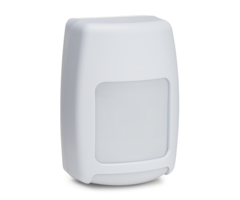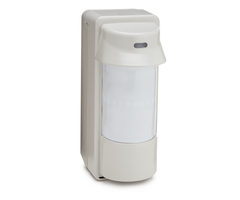Do Alarm Motion Sensors Work Through Glass?
No, alarm motion sensors do not work through glass. Most motion sensors use passive infrared (PIR) technology to detect motion. Changes in IR energy are not easily detected through glass. This is why motion sensors will generally not work through windows, which are usually insulated.
However, there are some exceptions to this rule. Older plate glass and other types of non-insulated glass may allow a greater amount of infrared energy to pass through, and it may be enough to set off a motion sensor. Additionally, light passing through a window may provide enough of a change in IR energy on a small concentrated area to trick a PIR motion sensor into activating. That is why we recommend placing motion sensors away from windows for best results.
But a microwave motion sensor in a dual-tech motion detector will work through glass, as microwave sensors are able to detect motion through solid objects. For this reason, care must be taken to adjust the microwave portion of the sensor properly during installation. These sensors work by sending out microwave signals that bounce off of any objects or obstacles in the area. The sensor will take note of how these signals return to the device. If there is any change in the return rate or the pattern of these signals, the sensor will know that motion is present. However, standalone microwave motion sensors do not exist, as they would cause too many false alarms. Instead, dual-tech sensors have both a microwave sensor and a PIR sensor. An alarm will only occur if both technologies are triggered simultaneously. The environmental factors that may cause a false alarm on a PIR sensor, such as the sun coming in through a window, would not cause an alarm on the microwave portion of the sensor. This is how dual-tech motions help to prevent false alarms.
This information may make it seem as though motion detectors are vulnerable in certain scenarios. That is why an alarm system consists of more than just motion detectors. Multiple security sensors, including motion detectors, glass break sensors, door and window contacts, all work together to protect a home or business from unwanted intruders. Each device has some vulnerability, but together, they make a complete security system.
Additionally, a scheme that involves using glass to hide an intruder would still be unable to trick microwave sensors, since this type of sensor will detect motion through the glass. And remember that all microwave sensors are dual-tech and they feature both motion and PIR sensors. Both the PIR sensor and the microwave sensor will need to activate in order for an alarm to occur. These sensors are designed this way to prevent false alarms on the system.
Did you find this answer useful?
We offer alarm monitoring as low as $10 / month
Click Here to Learn MoreRelated Products




Related Categories
- Motion Detecting Sensors
- Dual Tech Motion Detecting Sensors
- Honeywell Six Motion Detectors
- Long Range PIR Motion Detecting Sensors
- Honeywell 5800 Motion Detectors
- Answered



